Tywyn: Difference between revisions
Created page with ':''Not to be confused with Towyn, Denbighshire; Tywyn, Caernarfonshire nor Porty Tywyn, Carmarthenshire'' {{Infobox town |name=Tywyn |county=Merionethshire |picture=…' |
No edit summary |
||
| (7 intermediate revisions by 4 users not shown) | |||
| Line 1: | Line 1: | ||
{{Hatnote|Not to be confused with [[Towyn, Denbighshire]]; [[Tywyn, Caernarfonshire]] nor [[Burry Port]] (Porth Tywyn) in Carmarthenshire}} | |||
{{Infobox town | {{Infobox town | ||
|name=Tywyn | |name=Tywyn | ||
|county=Merionethshire | |county=Merionethshire | ||
|picture= | |picture=Tywyn Market Hall geograph 2559016.jpg | ||
|picture caption=Tywyn | |picture caption=Tywyn Market Hall | ||
|os grid ref=SH585004 | |os grid ref=SH585004 | ||
|latitude=52.58294 | |latitude=52.58294 | ||
|longitude=-4.08989 | |longitude=-4.08989 | ||
|population=2,864 | |population=2,864 | ||
|post town=Tywyn | |post town=Tywyn | ||
| Line 20: | Line 17: | ||
'''Tywyn''', also known as '''Towyn''', is a town and seaside resort of [[Merionethshire]]. It stands on [[Cardigan Bay]]. | '''Tywyn''', also known as '''Towyn''', is a town and seaside resort of [[Merionethshire]]. It stands on [[Cardigan Bay]]. | ||
The name is Welsh | The name is from the Welsh language, with ''tywyn'' meaning "beach", "seashore" or "sand-dune". Extensive dunes are still to be found to the south towards [[Aberdovey]], and in Tywyn itself the beach and the extensive promenade are key attractions. To the north lies the mouth of the [[River Dysynni]], to the north-east the rich farmland of Bro Dysynni, and to the east the hills of Craig y Barcud and Craig Fach-Goch. | ||
During the late 19th and early 20th centuries, the town was sometimes called ''Towyn-on-Sea''. At the time of the 2001, 40.5% of the population were Welsh-speakers. | During the late 19th and early 20th centuries, the town was sometimes called ''Towyn-on-Sea''. At the time of the 2001 census, 40.5% of the population were Welsh-speakers. | ||
==Churches== | ==Churches== | ||
[[File:St Cadfan's Church, Tywyn - geograph.org.uk - 430026.jpg|right|thumb|200px|St Cadfan's]] | [[File:St Cadfan's Church, Tywyn - geograph.org.uk - 430026.jpg|right|thumb|200px|St Cadfan's]] | ||
===Church of St Cadfan=== | ===Church of St Cadfan=== | ||
The parish church of | The parish church of Saint Cadfan is of Norman construction. Wihin it is found the St Cadfan's Stone dating from the eighth or ninth century and inscribed with the oldest known written Welsh. The church was sacked by Vikings in 963 and, during the 12th century was the subject of a memorable poem by Llywelyn Fardd. | ||
The earliest parts of the building date to the 12th century, and it originally had a central tower, although this fell down in 1693. The church houses two 14th century effigies, one of an unknown priest and the other a church monument of a military figure thought to be Gruffudd ap Adda (who died around 1350) of Dôl-goch and Ynysymaengwyn. | The earliest parts of the building date to the 12th century, and it originally had a central tower, although this fell down in 1693. The church houses two 14th century effigies, one of an unknown priest and the other a church monument of a military figure thought to be Gruffudd ap Adda (who died around 1350) of Dôl-goch and Ynysymaengwyn. | ||
| Line 54: | Line 51: | ||
===Anwyl of Tywyn Family=== | ===Anwyl of Tywyn Family=== | ||
{{main|Anwyl of Tywyn family}} | |||
Since around 1860 the Anwyl of Tywyn Family have lived outside the town at '''Ty-Mawr'''. Their ancestral home was at Parc near [[Penrhyndeudraeth]]. The Anwyl's are direct male line descendants of Rhodri ab Owain Gwynedd and as such are members of the House of Aberffraw and represent a surviving fragment of the mediæval Welsh princely families. | Since around 1860 the Anwyl of Tywyn Family have lived outside the town at '''Ty-Mawr'''. Their ancestral home was at Parc near [[Penrhyndeudraeth]]. The Anwyl's are direct male line descendants of Rhodri ab Owain Gwynedd and as such are members of the House of Aberffraw and represent a surviving fragment of the mediæval Welsh princely families. | ||
| Line 64: | Line 62: | ||
Agriculture and, since the arrival of the railway, tourism have been the most important industries in the area. The railway arrived in the mid-1860s, and had a significant effect on the town's development. Slate-quarrying in the Abergynolwyn area led to the building of the Talyllyn Railway in 1865, a narrow-gauge line designed to carry slates to Tywyn. This was the first railway in the world to be taken over and run by a volunteer-led preservation society, which took over the line in 1950 after the death of the previous owner, Sir Henry Haydn Jones. | Agriculture and, since the arrival of the railway, tourism have been the most important industries in the area. The railway arrived in the mid-1860s, and had a significant effect on the town's development. Slate-quarrying in the Abergynolwyn area led to the building of the Talyllyn Railway in 1865, a narrow-gauge line designed to carry slates to Tywyn. This was the first railway in the world to be taken over and run by a volunteer-led preservation society, which took over the line in 1950 after the death of the previous owner, Sir Henry Haydn Jones. | ||
The town's main line railway station is | The town's main-line railway station is situated on the Cambrian Line, with trains between [[Shrewsbury]] and [[Aberystwyth]]/[[Pwllheli]]. | ||
==Sights about the town== | ==Sights about the town== | ||
| Line 73: | Line 71: | ||
The Tywyn coastal defence scheme, a £7.6 million civil engineering project, to provide a new rock breakwater above the low-tide level, rock groynes, and rock revetment to protect 80 sea-front properties has been announced. | The Tywyn coastal defence scheme, a £7.6 million civil engineering project, to provide a new rock breakwater above the low-tide level, rock groynes, and rock revetment to protect 80 sea-front properties has been announced. | ||
==Outside links== | |||
*[http://www.snowdoniaguide.com/tywyn.html Tywyn an illustrated guide] | |||
*[http://www.bbc.co.uk/wales/northwest/sites/tywyn/ bbc.co.uk North West Wales: Tywyn] | |||
*[http://www.tywyn.info/radio.php Marconi Long Wave Receiving site in Tywyn] | |||
*{{geograph|3490233|Tywyn}} | |||
==References== | ==References== | ||
| Line 80: | Line 84: | ||
*Williams, Harri (1999). ''Marconi and his wireless stations in Wales'', Llanrwst: Carreg Gwalch. ISBN 0-86381-536-7 | *Williams, Harri (1999). ''Marconi and his wireless stations in Wales'', Llanrwst: Carreg Gwalch. ISBN 0-86381-536-7 | ||
*Hogan Jr, John L. ''A New Marconi Transatlantic Wireless Service'', Electrical World, Aug 29, 1914 | *Hogan Jr, John L. ''A New Marconi Transatlantic Wireless Service'', Electrical World, Aug 29, 1914 | ||
Latest revision as of 19:54, 1 November 2023
| Tywyn | |
| Merionethshire | |
|---|---|
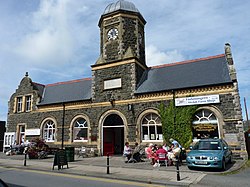 Tywyn Market Hall | |
| Location | |
| Grid reference: | SH585004 |
| Location: | 52°34’59"N, 4°5’24"W |
| Data | |
| Population: | 2,864 |
| Post town: | Tywyn |
| Postcode: | LL36 |
| Dialling code: | 01654 |
| Local Government | |
| Council: | Gwynedd |
| Parliamentary constituency: |
Meirionnydd Nant Conwy |
Tywyn, also known as Towyn, is a town and seaside resort of Merionethshire. It stands on Cardigan Bay.
The name is from the Welsh language, with tywyn meaning "beach", "seashore" or "sand-dune". Extensive dunes are still to be found to the south towards Aberdovey, and in Tywyn itself the beach and the extensive promenade are key attractions. To the north lies the mouth of the River Dysynni, to the north-east the rich farmland of Bro Dysynni, and to the east the hills of Craig y Barcud and Craig Fach-Goch.
During the late 19th and early 20th centuries, the town was sometimes called Towyn-on-Sea. At the time of the 2001 census, 40.5% of the population were Welsh-speakers.
Churches
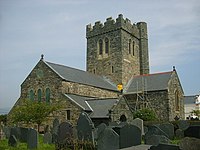
Church of St Cadfan
The parish church of Saint Cadfan is of Norman construction. Wihin it is found the St Cadfan's Stone dating from the eighth or ninth century and inscribed with the oldest known written Welsh. The church was sacked by Vikings in 963 and, during the 12th century was the subject of a memorable poem by Llywelyn Fardd.
The earliest parts of the building date to the 12th century, and it originally had a central tower, although this fell down in 1693. The church houses two 14th century effigies, one of an unknown priest and the other a church monument of a military figure thought to be Gruffudd ap Adda (who died around 1350) of Dôl-goch and Ynysymaengwyn.
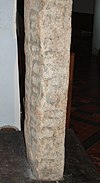
Other churches
- Church in Wales: St Cadfan (see above)
- Baptist: Tywyn Baptist Church
- Presbyterian:
- Bethany (English-speaking)
- Bethel (Welsh-speaking)
- Congregationalist: Bethesda
- Wesleyan Methodist: Ebeneser
- Roman Catholic: St David’s
History of people and houses
Ynysymaengwyn and the poets
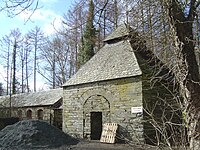
Many of the most notable residents of the parish have been linked to the great manor house of Ynysymaengwyn. 'Sir' Arthur ap Huw, the grandson of Hywel ap Siencyn of Ynysymaengwyn, was vicar of St Cadfan's between 1555 and 1570, and was a notable patron of the poets as well as being a translator of Counter-Reformation literature into Welsh.
The Ynysymaengwyn family were important patrons and many of the poems to them have been preserved in a manuscript of cywyddau (British Library Additional MS 14866) copied by a native of the Tywyn area, David Johns (wriing 1573-87), who was himself the great-grandson of Hywel ap Siencyn. Later additions to this manuscript contain several 18th-century Welsh poems, some of which relate to the Owen and Corbet family of Ynysymaengwyn and to the Rev Edward Morgan of Tywyn. Edward Morgan, the brother of the poet John Morgan, was vicar of St Cadfan's from 1717 and was one of the 18th-century owners of David Johns's manuscript. The poet and scholar Evan Evans (Ieuan Fardd, 1731–88) was curate of St Cadfan's between 1772 and 1777. During his time at Tywyn he was the bardic teacher of David Richards (Dafydd Ionawr) (1751–1827), a native of the parish.
During the 18th century, the Corbet family of Ynysymaengwyn played a leading role in the Tywyn area. They were responsible for draining much of the morfa or salt marsh between the town and the Dysynni river, which greatly increased the land available for farming in that part of the parish. In Samuel Lewis's A Topographical Dictionary of Wales (1833) it is reported that popular horse races were held on land by the Dysynni every September. The raven was the Corbet family emblem (an allusion to the Norman French for 'raven') and the bird is still used as emblem of Tywyn. The name Raven was once that of a public house in the centre of the town. One notable landlord of the Raven was Griffith Owen (1750–1833), who was both butler and harpist to the Corbets before he moved to the Raven. A portrait of him by Benjamin Marshall (1768–1835) was formerly at Ynysymaengwyn.
Ynysymaengwyn passed in time to the local council, who neglected the house and eventually demolished it.
Anwyl of Tywyn Family
- Main article: Anwyl of Tywyn family
Since around 1860 the Anwyl of Tywyn Family have lived outside the town at Ty-Mawr. Their ancestral home was at Parc near Penrhyndeudraeth. The Anwyl's are direct male line descendants of Rhodri ab Owain Gwynedd and as such are members of the House of Aberffraw and represent a surviving fragment of the mediæval Welsh princely families.
John Corbett
Ynysymaengwyn was bought by John Corbett of Chateau Impney, Droitwich in 1878. He was not related to the previous Corbet family, but the similarity of the names certainly attracted him. Although not a permanent resident, Corbett spent long periods and even more money in Tywyn, and some of the town's key features are the product of his investments. He developed the water and sewerage system and also constructed the promenade at a cost of some £30,000. He gave land and money for the Market Hall, built to celebrate Queen Victoria's Golden Jubilee in 1897. It was his money that enabled Brynarfor to be opened as Towyn Intermediate School in 1894. He rebuilt the Corbett Arms Hotel (thenceforth spelled with two 't's), and also contributed to the Assembly Room (1893), now Tywyn Cinema.
Plaques commemorating John Corbett's generosity may still be seen on the north end of the promenade and on the Market Hall. Brynarfor bore another before it was demolished. Despite the fact that his involvement transformed Tywyn, he was not much loved, and upon his death on 22 April 1901, the Cambrian News noted that "he had more than the usual reserve of the Englishman".
Transport
Agriculture and, since the arrival of the railway, tourism have been the most important industries in the area. The railway arrived in the mid-1860s, and had a significant effect on the town's development. Slate-quarrying in the Abergynolwyn area led to the building of the Talyllyn Railway in 1865, a narrow-gauge line designed to carry slates to Tywyn. This was the first railway in the world to be taken over and run by a volunteer-led preservation society, which took over the line in 1950 after the death of the previous owner, Sir Henry Haydn Jones.
The town's main-line railway station is situated on the Cambrian Line, with trains between Shrewsbury and Aberystwyth/Pwllheli.
Sights about the town
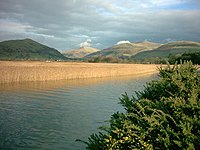
Tywyn was a major training ground for the amphibious warfare landings in the Second World War and had a strategic war base. Abandoned pillboxes may still be seen on the coast to the south of the town,
Local places of interest include Craig yr Aderyn (Bird Rock), Castell y Bere and Tal-y-llyn Lake.
The Tywyn coastal defence scheme, a £7.6 million civil engineering project, to provide a new rock breakwater above the low-tide level, rock groynes, and rock revetment to protect 80 sea-front properties has been announced.
Outside links
- Tywyn an illustrated guide
- bbc.co.uk North West Wales: Tywyn
- Marconi Long Wave Receiving site in Tywyn
- Pictures of Tywyn and the area on Geograph.co.uk
References
- Middlemass, Barbara & Joe Hunt (1985). John Corbett: Pillar of Salt, 1817-1901, Droitwich: Saltway Press. ISBN 0-95104-630-6
- Smith, J. Beverley & Llinos Beverley Smith (eds) (2001). History of Merioneth, vol. ii: The Middle Ages, Cardiff: University of Wales Press. ISBN 0-70831-709-X
- Williams, Harri (1999). Marconi and his wireless stations in Wales, Llanrwst: Carreg Gwalch. ISBN 0-86381-536-7
- Hogan Jr, John L. A New Marconi Transatlantic Wireless Service, Electrical World, Aug 29, 1914